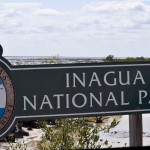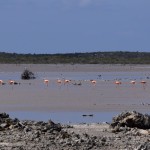We wobbled onto land to check in on Saturday morning to Matthews Town. We immediately found the locals to be immensely kind – amazingly generous. There were two locals who gave us a ride to the police station to check if the Customs/Immigration office would be open on a Saturday. The police stationed phoned the C/I who drove over to pick us up at the police station before clearing us into the Bahamas. We paid $300 USD in cash to clear in which gave us a cruising and fishing permit for a year and the ability to leave for up to 3 months and return without clearing in/out!
Matthews Town wasn’t all that exciting, it had a screened in gazebo/hut with free wifi but even the prospect of free wifi didn’t stop our progression to a new anchorage. We anchored in Man O War bay just South of the Morton Salt dock. It was there we snorkeled the crystal clear Bahamian blue. We decided to splurge and take a tour of Great Inagua.
We consulted the ‘Active Captain’ reviews and called a guide named Casper and made arrangements to meet him on the beach the next day. It would be $100 for the tour but that went straight to the Bahamian Trust. Friendly and welcoming, he helped us drag our dinghy onto the beach and then we all fled for our lives from the relentless mosquitos; retreating into his nice SUV. Having grown up in Great Inagua and traveled to a few other islands working various jobs for the Bahamian Nation Trust, Casper was well versed in the history, ecology, and economics of Great Inagua as well as the rest of the Bahamas. We learned what a potcake was – it’s what locals call their stray dogs (named so because that’s what people fed them – potcakes – the burnt rice on the bottom of a pan). He told us of how the salt mining industry grew from a few locals building salt ponds and working endlessly which progressed to the Erickson family coming in & investing in machinery and scaling production until Mortons Salt Company took over operations. Casper also told us about the flamingo populations and how they migrated from island to island but it was at Great Inagua, deep in the reserve the flamingos would come by the thousands to nest. Once we were as close as we could get (about a mile away), he took out a heavy duty telescope and sure enough the entire horizon, dotted with pink flamingos, came to life and you could see all the grey puffs of baby flamingos huddled at the feet of the adults. We saw groups of flamingos all around but it was the nesting ground that blew me away.
- driving a bumpy rocky path
- we saw pockets of flamingos
- dry flat landscape
- we stopped to see a few ground owls
- what the old salt plantations looked like
- Mortons Salt pond









